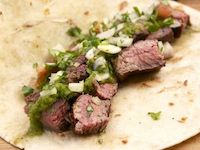 |
Texas Fajitas from Whatscookingamerica |
If tacos are an ancient Aztec dish pre-dating the arrival of the Spanish, fajitas are largely a modern Gringo affair from the 1970s.
Fajitas, like tacos, are absolutely delicious! In its most basic form, what is understood as fajitas today, is sliced grilled meat, cooked with onions and bell peppers, eaten in a folded tortilla, garnished with a combination of salsa, pico de gallo, guacamole, sour cream, shredded lettuce, cheese and tomato. If beef is used, it is usually skirt steak, marinated overnight. Chicken, shrimp or pork are also be used. However, the original fajitas from the 1970s were only beef, and only one specific cut of beef: the skirt steak.
Skirt steak is the muscle that separates the lungs from the stomach in the cow. It is very flavorful meat, but very fibrous when raw and very tough. A good marinade is the only solution!
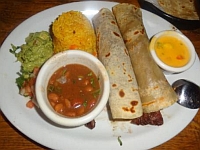 Taco Al Carbon at Ninfa's in Houston. Illustration photo from Tripadvisor. |
Fajitas are a Tex-Mex affair. Texas likes to lay a claim on fajitas as being a Texas dish, but based on historical facts fajitas are a fusion dish combining traditions from Texas and from northern Mexico. Fajitas have taken America by storm since their commercialization in late 1960s, through popularization at fajita stands at festivals and fairs, and Tex-Mex restaurants in Houston, Austin and San Antonio, but they were still largely unknown outside of Texas until the 1990s. So, the essential question presents ifself: how did a throwaway cut of beef such as the skirt steak make it to a star on the menu? A 1985 thesis at Texas A&M University (the "Aggies") provides the answer. It traces the origin of fajitas (and its northern Mexican equivalent, the arrachera) to the 1930s in the shared history of northern Mexico and Texas, specifically to the Rio Grande Valley in southwestern Texas.
 Rio Grande Valley. |
 Arrachera from northern Mexico. Image from Photocrawler. |
The tradition of eating grilled, marinated skirt steak remained confined to southwestern Texas and relatively obscure for decades.
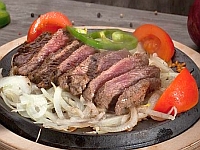 Beef fajitas served on a sizzling platter. |
 Fajita condiments served separately. |
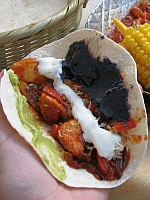 Fajitas being assembled. |
Fajitas started to make the leap from the cowboy campfire to commercial success in 1969. Otilia Garza was the owner of the "Round-Up Restaurant" in the city of Pharr, Texas. Pharr is a fairly sizable place on the Rio Grande River, founded in 1910 by Henry Newton Pharr, the former director of the State National Bank of New Iberia, Louisiana, and president of the Louisiana-Rio Grande Sugar Company and the Louisiana-Rio Grande Canal Company. At Garza's restaurant, strips of grilled skirt steak were served on a sizzling platter, with warm flour tortillas and mounds of condiments: pico de gallo (chopped fresh onions, tomatoes, peppers, and cilantro), guacamole, and grated cheese. This is becoming to sound very much like Fajitas!
Garza maintained that she had learned the tradition of grilling skirt steak from her grandmother, also a restaurateur in the much larger city of Reynosa, just across the river in the Mexican state of Tamaulipas. Reynosa is a much older and much larger place. It was founded in 1749 and named Villa de Nuestra Señora de Guadalupe de Reynosa, as a tribute to the town of Reinosa in northern Spain, which was the birthplace of the Viceroy of New Spain at the time.
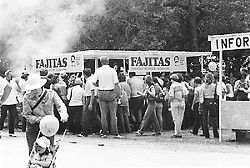 Sonny Falcon's fajita stand Photo from The Austin Chronicle & and the Falcon Family. |
He may not have invented the dish, but he did invent the name. The shape of the raw shirt steak reminded him of a belt; "Faja" means "belt" in Spanish, "fajita" means "little belt", and voilà, the name Fajita has just been created! Sonny became personally identified with the dish by the late 1970s, when an Austin reporter christened him "The Fajita King".
 Mama Ninfa. |
 Ninfa's Restaurant. |
While Tex-Mex restaurants like Ninfa's were popularizing fajitas in Houston during the 1970s, Sonny Falcon was cooking them for thousands of people at his concession stands at rodeos, outdoor fairs, and festivals all over Texas. The next big fajita breakthrough came, of all places, from Germany! In 1982, The Hyatt Regency Austin hotel opened on Barton Springs Road. The hotel restaurant had a chef de cuisine, a German by the name of George (Georg) Weidmann. He promptly recognized the commercial potential of the popular local Tex-Mex dish. He put "sizzling fajitas" on the menu of the Hyatt's La Vista restaurant, and soon sales of that dish made it the most profitable restaurant in the Hyatt chain. The "SWB Famous Fajitas" are still on the menu at the Southwest Bistro at the Hyatt today ($30 for two).
Today, the term fajita has completely lost its original meaning and has come to describe about any meat that is grilled or pan-fried, and served rolled up in a soft flour tortilla. The more popular the dish became, the less likely it was to be made from skirt steak. This started with Weidmann. He spent 20 years of his career at the Austin Hyatt, perfecting and marketing his fajitas not only at the Austin hotel but throughout the Hyatt chain as a whole. His fajita secred was not using the traditional skirt steak, but the more tender sirloin.
By the mid-1980s, fajitas were a fairly common dish in most Tex-Mex restaurants and would ultimately become a popular Nineties fast-food item, bastardized by places such as Jack in the Box and Taco Bell.
In the brave new world of globalization that blossomed after the fall of Communism, things like Tex-Mex cuisine got the green light to spread all over the world. Busts of Lenin were replaced with cowboy boots and other symbols of the Old West, generally idolized by many Europeans. The love affair with stories from the Old West is expecially strong and deep rooted in places like Germany and the Czech Republic, thanks largely to the 19th century books by Karl May but also Zane Grey, Jack London and others. Weekend camps with totem poles where people escape to for the weekend to sing around a camp fire and play Cowboys and Indians abound. It is therefore no surprise that Tex-Mex restaurants were some of the first businesses that sprung up after Communism folder at the end of 1989.
 Jo's Bar & Garáž in Prague. |
 Buffalo Bill's in Prague. |
 Taco Y Tequila in Munich. |
Here is a recipe we like from What's Cooking America.

Original Texas Fajitas
Ingredients for the marinade:
- Juice of 4-5 fresh-squeezed limes
- 1/4 cup red wine vinegar
- 1 tbsp soy sauce
- 1 tbsp light molasses
- 1 tbsp chopped fresh cilantro leaves
- 2 cloves garlic, minced
- 1/2 tsp ground cumin
- 1/2 tsp black pepper
Ingredients for the guacamole:
- 3 large, ripe avocados, cut into 1/2-inch cubes
- 1 large red onion, finely diced
- 1 or 2 ripe jalapeño chile peppers, seeds removed and finely diced
- 1 clove garlic, crushed with 1/8 teaspoon coarse or sea salt
- 1/8 tsp red chile powder
- 1 tsp freshly-squeezed lemon juice
- 1 large tomato, diced (optional)
Ingredients for the tomato salsa:
- 6-7 medium-size fresh tomatoes, diced
- 1 large onion, diced
- 1 bunch fresh cilantro, finely chopped
- 6 cloves garlic, minced
- 1 alapeño chile pepper (stems, ribs, & seeds removed), very finely diced
- Juice of 1 lime
- Coarse salt to taste
Ingredients for the main dish:
- 1 1/2 pounds skirt steak or flank steak
- 1 green or red bell pepper, cored, seeded, and thinly sliced
- 1 small onion, thinly sliced
- 3 tomatoes, chopped
- Cheddar cheese, shredded
- Sour cream
- Guacamole
- Tomato Salsa
- Flour Tortillas
Preparation:
- Prepare the marinade:
- In a large re-sealable plastic bag, combine lime juice, vinegar, soy sauce, molasses, cilantro, garlic, cumin, and pepper.
- Set aside.
- Prepare the guacamole:
- Cut the avocado exposing the meat and the seed inside, remove the seed, and the meat.
- Roughly chop the meat into cubes. Add the onion, jalapeño chile peppers, garlic, salt, and chile powder. Mix with a fork, mashing some but not all of the cubes of avocado.
- Add the lemon juice and stir well. The lemon will help delay some of the oxidation.
- Prepare the salsa:
- In a large bowl, combine the tomatoes, onion, cilantro, garlic, chile pepper, salt, and lime juice. If the salsa is too hot, add some additional chopped tomato. If not hot enough, carefully add a little more chile pepper.
- Set aside and allow to marinade for 1 hour.
- Prepare the meat. Lay the skirt steak on a cutting board and remove the outer membrane using a sharp paring knife. Make a number of slits in the meat, cutting both with and against the grain of the meat (this cuts the muscle fiber and reduces any toughness.)
- Place the skirt steak in a large plastic bag and add the marinade. Seal the bag and marinate in the refrigerator overnight, turning the steak occasionally.
- Remove the steak from refrigerator and bring to room temperature before cooking.
- Light the charcoal grill. Preheat the oven to 350 degrees F
- Warm up the tortillas. Wrap stacked flour tortillas in aluminum foil and place in the oven. Heat for about 15 minutes to make them soft and pliable.
- Meanwhile, drain the steaks, reserving the marinade. Place the steaks on the hot grill and spoon some of the reserved marinade over the steak. Close the lid, open any vents, and cook 3 to 5 minutes for medium-rare. While the meat is cooking, grill the green peppers and onion slices, 1-2 minutes or until soft.
- Remove the meat and vegetables from the grill. Transfer the meat on a cutting board and slice diagonally across the grain into thin strips. Arrange everything on a serving platter.
- For each fajita, fill a warm flour tortilla with cooked steak strips and desired amounts of green pepper and onion slices. Top to your liking with tomatoes, cheddar cheese, sour cream, guacamole, and salsa as desired. Fold up like a taco and enjoy!
Sources:
- Fajita History by Virginia Wood, The Austin Chronicle, March 4, 2005, http://www.austinchronicle.com/food/2005-03-04/261130/
- Fajita history on Whatscookingamerica.net, http://whatscookingamerica.net/History/FajitaHistory.htm
- Eating at "Ninfa's On Navigation, desde 1973", 2704 Navigation Blvd, Houston, Texas, U.S.A.
- Zoning records of the Austin city government, http://www.austintexas.gov/edims/document.cfm?id=199591
back to Radim and Lisa's Well-Travelled Cookbook | email us
Last updated on June 1, 2014
